CATHOLIC PILGRIMAGE | BY: THE ROSARY HOUR PODCAST
[2nd Edition published on February 25, 2025 - Memory of the 9th Apparition at Lourdes] and in Anticipation of the 27 Fevereiro 1892 Tragedy]
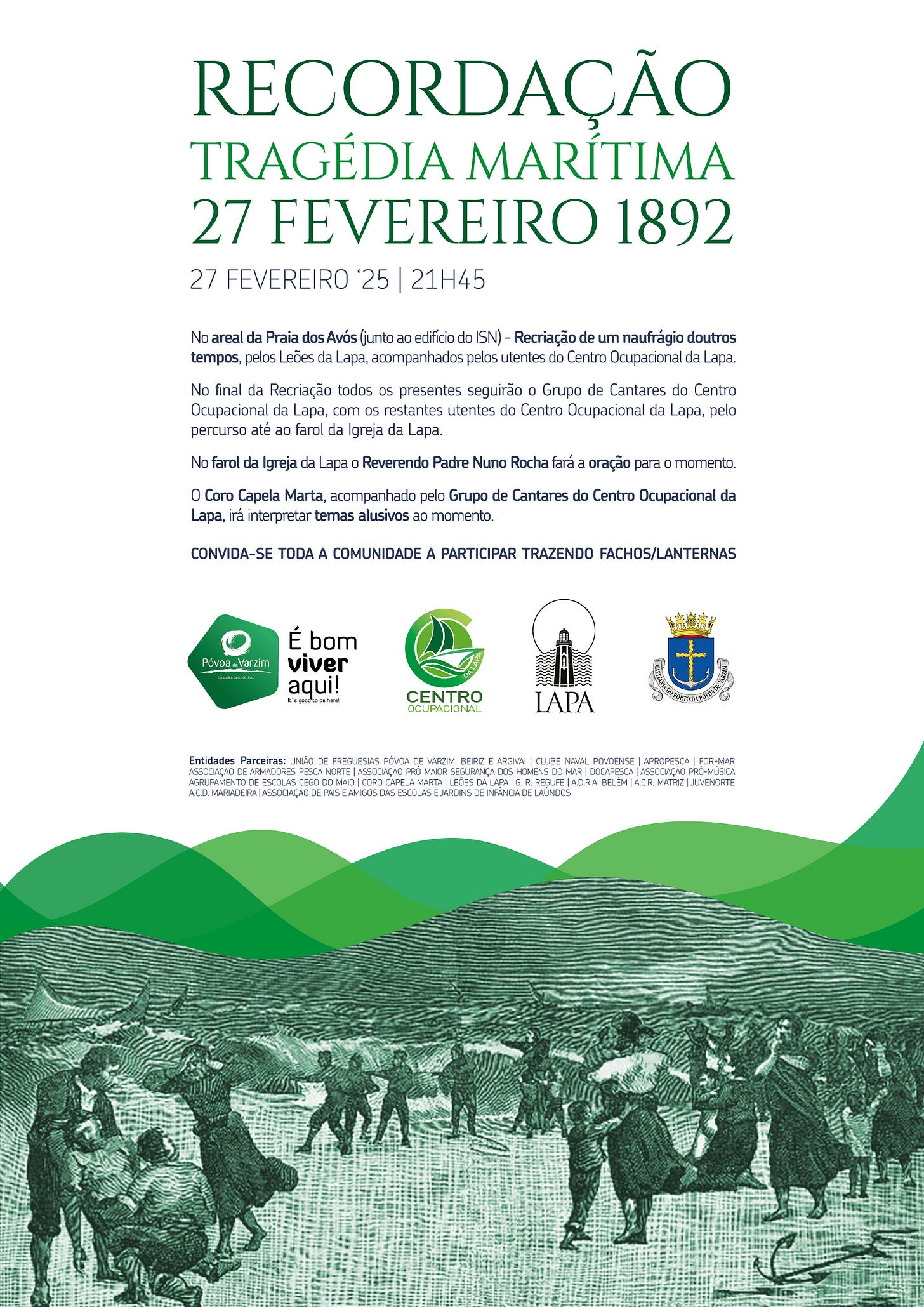
THE ROSARY HOUR PODCAST NEWSLETTER | CATHOLIC PILGRIMAGE SECTION
Podcast Spiritual Direction by: Fr. Thad Lancton, MIC (National Shrine of the Divine Mercy) and Fr. Elias Mary Mills (FI). Season 3 Content Spiritual Director: Fr. Nuno Rocha (Portugal)
Welcome to “Catholic Pilgrimage”, a beta newsletter subsection of the Rosary Hour Podcast that focuses on pilgrims going to Catholic pilgrim sites around the world.
What is the focus of any pilgrimage?
Well, according to the Basilica of the National Shrine of the Immaculate Conception in Washington, D.C.1:
“The focus of any pilgrimage is prayer, specifically the celebration of Eucharist. The oldest pilgrimages, second only to those to the Holy Land to walk the paths of Jesus, are the Marian pilgrimages. The faithful journeyed to the place of miraculous images and apparitions to offer prayers of intercession, thanksgiving, and devotion.”
The National Shrine continues:
“Little has changed over the centuries. What is different, unique, about pilgrimages to the National Shrine, is that the pilgrim is offered the opportunity to pray at “pilgrimage sites” from around the world in one location: a world of Marian devotion under one roof.
In his video discussion above, reformatted for this podcast, Fr. Thaddaeus Lancton mentions this shrine which states, once again that,
“Each chapel or oratory is adorned with either a certified exact copy, or an heirloom replica, or an original work of art depicting the Blessed Mother. When crossing the threshold into one of the chapels or oratories, the pilgrim enters not only a new space but also a different ethos by virtue of culture, ethnicity, and spirituality. The journey into each chapel or oratory is a pilgrimage unto itself, a pilgrimage within a pilgrimage.”
It is these “side chapels” of which Fr. Thad speaks… and they are the chapels to which people would attempt to visit to receive many Holy Communions before Canon Law placed a cap on two a day.
That being said, the Vatican has published through the Holy See the following document which transforms us into pilgrims of hope by encouraging, among many other pilgrimage options, the supernatural charity that comes about from pilgrimaging to the Holy Communion TWICE in one day by attending TWO full Holy Masses on any given day:
PILGRIMS OF HOPE can download the full document here:
https://press.vatican.va/content/salastampa/en/bollettino/pubblico/2024/05/13/240513f.pdf
READ THE FULL JUBILEE INDULGENCE DOCUMENT IN ENGLISH
LEIA O DOCUMENTO COMPLETO EM PORTUGUÊS AQUI:
The National Shrine notes on today’s event post for its Marian talk that
“Whether a pilgrim to Jerusalem or a pilgrim to Mary’s Shrine in Washington, D.C., each discovers the same basic truth: being a Christian is a pilgrimage and Eucharist is our prayer.”
In today’s Live Record hosted by Amelia, Fr. Thaddeus Lancton, MIC from the National Shrine of the Divine Mercy explains the pilgrim journey we can make in 2025 that Pope Francis has added to his Plenary Indulgence Jubilee 2025 Ordinary decree and which can be accomplished by those who have in their hearts the sacrificial spirituality of St. Jacinta Marto.
In this sense, we can tend to the needs of the Holy Father like St. Jacinta by following his instructions given as of May 13, 2024, the Feast of Our Lady of Fátima last year. In this document, he encourages all the Faithful of the world to make the pilgrimage to pray for Holy Souls by paying forward a greater sacrifice of going to two Holy Masses in one day, given all the requirements for gaining a plenary indulgence (which requires we go to the Holy Communion in a state of grace, with the firm resolve to be faithful to sanctifying grace, and to stay the entire Mass as Fr. Thad explains in the above video). This is a great opportunity for the Church to assist Holy Souls, the focus of Season 3, and our theme of Sanctity and the Secret of Joy.
As part of today’s Feast, as we learn more about St. Jacinta in the article below, we can learn to pray the Anima Christi as suggested by St. Ignatius of Loyola. This practice is suggested to all the Faithful after receiving the Holy Communion.
THE ANIMA CHRISTI
We might also even add at the consecration, a fervent set of words that both Cardinal Collins and Fr. Chris Alar have taught our podcast members to recite even at this point of the Holy Mass:
Upon the priest’s raising of the Body of Christ at the Consecration of the Sacred Host in the Holy Sacrifice of the Mass, look with reverence upon the Lamb of God, and speak to Him with all your heart (even in a whisper):
“My Lord, and My God, My Lord, and My God, My Lord, and My God. Have mercy on me a poor sinner. Have Mercy on me and on the Whole World.”
Then, to repeat this with the name of the Holy Soul being prayed for in the 2nd Holy Mass with this variation: “My Lord, and My God, My Lord, and My God, My Lord, and My God. Have mercy on me a poor sinner. Have Mercy on ______________(insert name of person who is deceased and who you wish to receive Holy Communion for) a poor sinner. Have mercy on the Whole World
Upon the priest’s raising of the Blood of Christ as the Consecration of the wine, look with reverence on the chalice and say with all your heart (even in a whisper):
“Lord Jesus Christ, Son of the Living God, have mercy on me a poor sinner. Have mercy upon the whole world.
Then, to repeat this with the name of the Holy Soul being prayed for in the 2nd Holy Mass.Lord Jesus Christ, Son of the Living God, have mercy on ____________ (insert name of person who is deceased and who you wish to receive Holy Communion for) a poor sinner. Have mercy upon the whole world.
Both Cardinal Collins and Fr. Alar, who were guests to this podcast, have noted the importance of bringing to this moment of the Holy Sacrifice of the Mass this kind of profound reverence for the Real Presence. If we can do this for both ourselves and the Holy Soul which we are praying for, it allows our intention to be heard within the Holy Mass as you utter to Heaven the act of supernatural charity for which you are offering this intention.
After the Holy Communion, you can then pray the Anima Christ in Latin, English, or your maternal the language as recommended by St. Ignatius of Loyola. Here is the script you would use, as an option to pray for a Holy Soul, and which allows you to make this offering intentional as if they were themselves making this request.
CATHOLICPILGRIMAGE.SUBSTACK.COM | 20 FEBRUARY 2025
FESTA EM PORTUGAL
Jacinta Marto: a brief life, an eternal testimony of faith2
Original Article presented by: The Sanctuary of Fátima, and translated for pilgrims to Portugal & those interested in the Spirituality by Travessa da Senra House Press | PORTO, PORTUGAL | FOR EDUCATIONAL USE PURPOSES ONLY. SEE FOOTNOTES FOR THE ORIGINAL ARTICLE.
On the 105th anniversary of the death of the youngest seer of the Fatima apparitions, we trace the picture of the young girl who made her life an example of surrender to God.
This day, February 20th, the Church marks the Feast of Saints Francisco and Jacinta Marto. A date defined in the liturgical calendar by way of the day that Jacinta Marto died — February 20, 1920 at D. Estefânia Hospital in Lisbon, Portugal. She was a victim of a serious lung infection which resulted from the Spanish Flu that profoundly weakened her health.
On the anniversary of Santa Jacinta Marto’s death, the Sanctuary of Our Lady of Fatima presents the life of this “little seer” from the perspective of ten quotations cited from Sister Lúcia's Memoir3, and through which we can grasp the personality, sensitivity and spiritual depth of this little seer.
"A menor contenda, das que se levantam entre as crianças, quando jogam, era bastante para a fazer ficar amuada, a um canto, a prender o burrinho, como nós dizíamos."
This translates as: "The smallest contention which might arise between children when they play, would be enough to make them sulk in a corner, like restraining the donkey, as they say."
Little Jacinta had a sensitive, touchy temperament. She was hurt by small setbacks in little children's games, of which she would turn away from and no longer play. This attitude demonstrates the natural immaturity of a 7-year-old child, however, it also demonstrates a resolute personality, a quality that would be expressed more explicitly in the future by requests of the "Lady brighter than the sun". ("Senhora mais brilhante que o sol".)
"Tinha, no entanto, já então, um coração muito bem inclinado, e o bom Deus tinha-a dotado dum carácter doce e meigo que a tornava, ao mesmo tempo, amável e atraente."
This citation translates as: "She had, however, even then, a deep-seated heart, and the good Lord had bestowed upon her a character sweet and gentle that at the same time make her both lovable and attractive."
Contrary to her childish stubbornness was Jacinta’s sweetness recognized by her friends and family. Even filled with anger, her natural kindness captivated those who surrounded her. In one instance, the small Jacinta who took responsibility for her cousin to hold a crucifix, and faced with a notable reprimand from Lúcia's older sister so that she “not touch the beloved saints”.
Jacinta said, “Maria, don’t scold! It was me, but I won’t do it again” (“Maria, não ralhes! Fui eu, mas não torno mais”). This courageous sweetness disarmed Maria dos Anjos, who responds with a caress.
"Coitadinho de Nosso Senhor! Eu não hei de fazer nunca nenhum pecado. Não quero que Nosso Senhor sofra mais."
This translates as: "Poor Our Lord! I will never commit any sin. I don't want Our Lord to suffer any more."
The episode reported in the previous tale takes place at one of the moments when Lúcia was telling her cousins about the Passion of Christ, which she frequently heard from her Mother. The story of Jesus' suffering touched the heart of little Jacinta deeply, who was unable to contain her tears as a result of the deep compassion and love she had for Christ crucified. Perhaps it was this awareness of the Paschal sacrifice of the Son of God which led her always to try avoid sin with firm resolve, and, later, to offer her own suffering for the conversion of sinners.
"Então eu vou para o meu pátio, com o Francisco."
Translates as: "And so, I will go to my patio, with Francisco."
Her clarity of thought in self-expression when it came to avoiding sin is evident in an episode narrated by Lúcia in her “Memoir”, in which Jacinta faced regarding a game in which one of the children uttered indecent words, and she decides to stay away and play by herself with Francisco. This moment expresses this child’s desire to assume a way of persevere in purity of heart, a virtue that he would come to cultivate with the apparitions of Our Lady.
“E os sacrifícios como os havemos de fazer?” (Santa Jacinta)
The above translates as: “And of sacrifices how should we [go about] making them?”
Jacinta interiorized from the first moments this request and message communicated by Our Lady in her apparitions, and she expressed, from the beginning, a conscious inclination for sacrifice and penance. One day, when the three of them arrived at the sheep’s pasture, she sat with introspection on a rock thinking about the best approach to obeying the Mother of God. “And of sacrifices how should we [go about] making them?”, [Jacinta] asks Lúcia and Francisco. Her brother suggests that they give the sheep their lunch, a hypothesis that is readily accepted by all.
"Então, depois de muitos, muitos anos, o inferno ainda não acaba?" (Sta. Jancinta)
"So after many, many years, hell still doesn't end?" (St. Jancinta)
After the vision of hell, during the apparition on the 13th of July 13, 1917, Jacinta demonstrated compassion and extreme concern for the souls who would have to go through such suffering. This understanding would lead the little seer to assume a kind of conscious ‘spirit of sacrifice’, with the goal of saving souls. At a time when the three (children) decide to offer the sacrifice of going thirsty, at the height of summer, Jacinta, despite her debilitating condition, remains firm in her resolve: “Tell the crickets and frogs to be quiet! My head hurts so much!” (“Diz aos grilos e às rãs que se calem! Dói-me tanto a minha cabeça!”), she asks her brother, who then questions her: “Don't you want to suffer this for sinners?” (“Não queres sofrer isto pelos pecadores?”), “Yes, I do. Permit them sing” (“Sim, quero. Deixa-as cantar”) she promptly responded.
"Se eles te matarem, diz-lhes que eu e mais o Francisco somos como tu e que também queremos morrer."
"If they kill you, [Lúcia], tell them that Francisco and I are like you and that we also want to die."
The fidelity to Our Lady's message was a non-negotiable for Jacinta, especially in their moments of greatest apprehension and uncertainty. When Lúcia was called by the authorities to be interrogated, her cousin feared that she would be threatened with death due to the pressure that she would be subjected to for denying the apparitions. Not permitting herself to be intimidated, Jacinta demonstrated an unshakable solidarity and courage one would not expect from a 7-year-old child, assuming without fear that she would have the disposition to accept the greatest sacrifice for her faith. This inner character demonstrates an irreducible alignment with the instructions given to her by Our Lady.
"Quem me dera ver o Santo Padre! Vem cá tanta gente e o Santo Padre nunca cá vem."
TRANSLATION: "I wish I could see the Holy Father! So many people come here and the Holy Father never comes."
The phrase was uttered by Jacinta after she noticed, via the explanations of two priests, one of whom was the Holy Father. From that very moment, the little visionary began to develop a special ardour for the Pope, for whom she began to pray frequently, while expressing great love and concern for the Successor of Peter. One afternoon, in a vision, Jacinta saw the Holy Father in a “very large house, on his knees, in front of a table, with his hands on his face, crying” (“casa muito grande, de joelhos, diante de uma mesa, com as mãos na cara, a chorar”), with some people outside throwing stones at him and swearing at him. From this moment on, her genuine worry for the Supreme Pontiff intensified.4
"Eu, agora, já não bailo mais." | ON SACRIFICE
"I, now, shall not dance anymore."
In her Memoir, Lúcia refers to Jacinta’s particular like for dancing, as characterized by the account of the time when she was in prison, relaying an episode of the little seer dancing with an inmate to the tune of a harmonica. Regardless, Jacinta renounced this pleasure during the Carnival and during São João festival. "I, now, shall not dance anymore."(“Eu, agora, já não bailo mais”), she said, on these [two] festive occasions, offering a sacrifice to Our Lord.
"Eu ofereço por todas, porque gosto muito de todas." | ALL INTENTIONS
"I offer them all, because I really like them all."
Jacinta had a profoundly generous heart and was unable to choose a particular intention when she was praying the Rosary. A phrase [Jacinta] said, according to Lúcia, in the context of prison, when the three Little Shepherd children each decided to pray for one of their intentions. When interrogated as to which one she would pray for, little Jacinta refuses to choose just one and decided to offer prayer for all intentions.
Jacinta fell ill in the fall of 1918 with Spanish flu. As a result of the illness, in the summer of the following year she was hospitalized at the Vila Nova de Ourém Hospital. The following year, due to the worsening of a lung infection, she was admitted to the D. Estefânia Hospital, in Lisbon, on February 2, 1920, where she died, aged just 9, on the 20th day of that same month.
Although brief, Jacinta Marto's life was marked by a profound dedication to the requests that Our Lady left in the apparitions of 1917. With a sensitive temperament, but with courage and unshakable faith, Jacinta would be canonized with her brother, Francisco Marto, on May 13, 2017, 100 years after the first apparition, by Pope Francis. Today, he is an example of faith for the entire Church.5
ORIGINAL SOURCE TEXT: TRANSLATED FOR EDUCATIONAL USE PURPOSES ONLY AND TO TEACH THE SPIRITUALITY OF ST. JACINTA on HER FEAST DAY. PRAY THE ROSARY EVERY DAY. TODAY IS THURSDAY — USE THE FOLLOWING VIDEO TO TEACH A CHILD HOW TO PRAY THE ROSARY:
SEE: https://www.fatima.pt/pt/news/jacinta-marto-uma-vida-breve-um-testemunho-de-fe-eterno
[NOTE: As this is the first draft, we will update this page again for the 2nd Edition. Please return back later. If you have a pilgrim journey you wish for us to focus on, comment below]. Thank you for reading.
Video Narration: Fr. Chris Alar, MIC, Provincial Superior of the National Shrine of the Divine Mercy and Amelia. See also our latest video on St. Paul Miki and Companions with Fr. Elias Mary Mills who takes you on a pilgrim journey to Japan via our Rosary YouTube Channel here: https://www.youtube.com/watch?v=mUq5aZLjbqE
FOOTNOTES
https://www.nationalshrine.org/event/heritage-talk-eucharist-and-pilgrimage-the-great-intercessory-prayer/
Jacinta Marto: uma vida breve, um testemunho de fé eterno
READ THE MEMOIR OF ST. LUCIA IN PORTUGUESE
https://www.fatima.pt/files/upload/fontes/F002_Memorias1.pdf read the Original Portuguese. The apparitions have been translated by Travessa da Senra House Press. Check our newsletter for updates on our presentation of these segments.
LINK TO OUR POST ON ST. LUCIA FOR THE MEMOIR IN ENGLISH:
It was Jacinta who prayed three Hail Marys for the Holy Father, which is added to the end of the Holy Rosary in Portugal, and which will be featured in the future post led by Fr. Elias and Fr. Nuno.
Jacinta adoeceu no outono de 1918 com gripe espanhola. Em consequência da doença, no verão do ano seguinte esteve hospitalizada no Hospital de Vila Nova de Ourém. No ano seguinte, devido ao agravamento de uma infeção pulmonar, foi internada no Hospital de D. Estefânia, em Lisboa, a 2 de fevereiro de 1920, onde viria a falecer, com apenas 9 anos, no 20.º dia desse mesmo mês.
Apesar de breve, a vida de Jacinta Marto fica marcada por uma profunda entrega aos pedidos que Nossa Senhora deixou nas aparições de 1917. De temperamento sensível, mas de uma coragem e fé inabalável, Jacinta viria a ser canonizada com o seu irmão, Francisco Marto, a 13 de maio de 2017, 100 anos após a primeira aparição, pelo Papa Francisco. Hoje, é exemplo de fé para toda a Igreja.







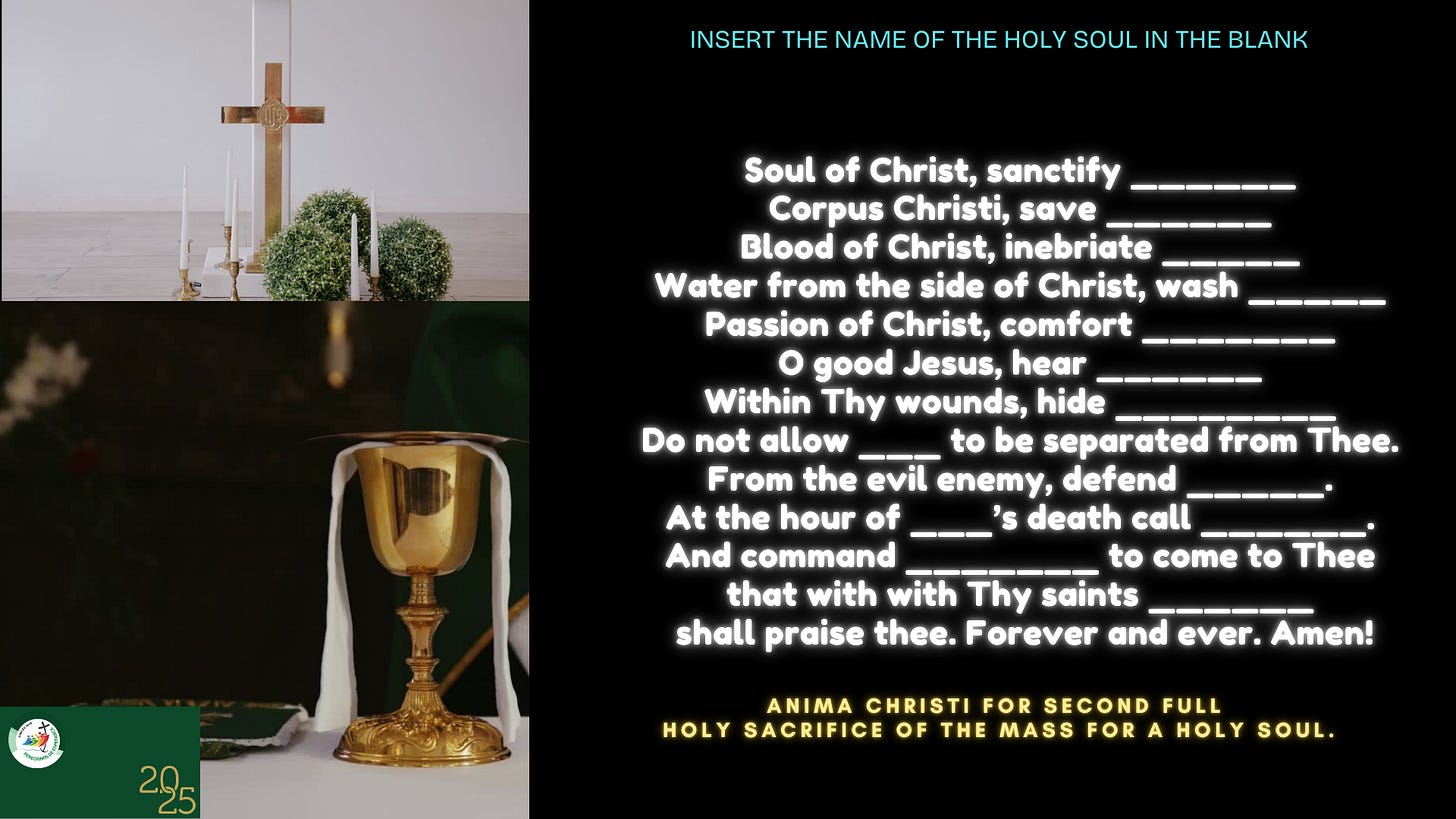
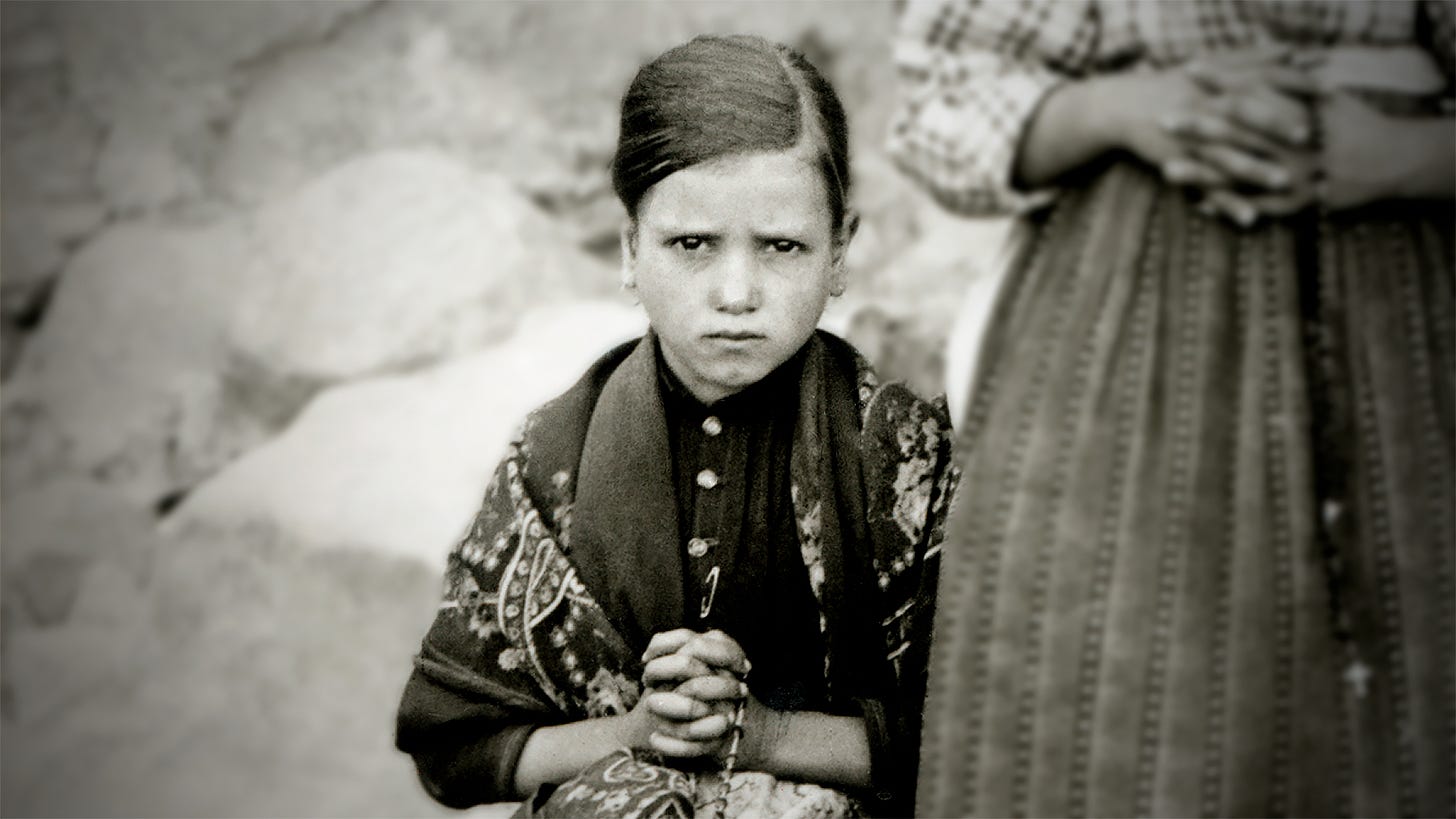
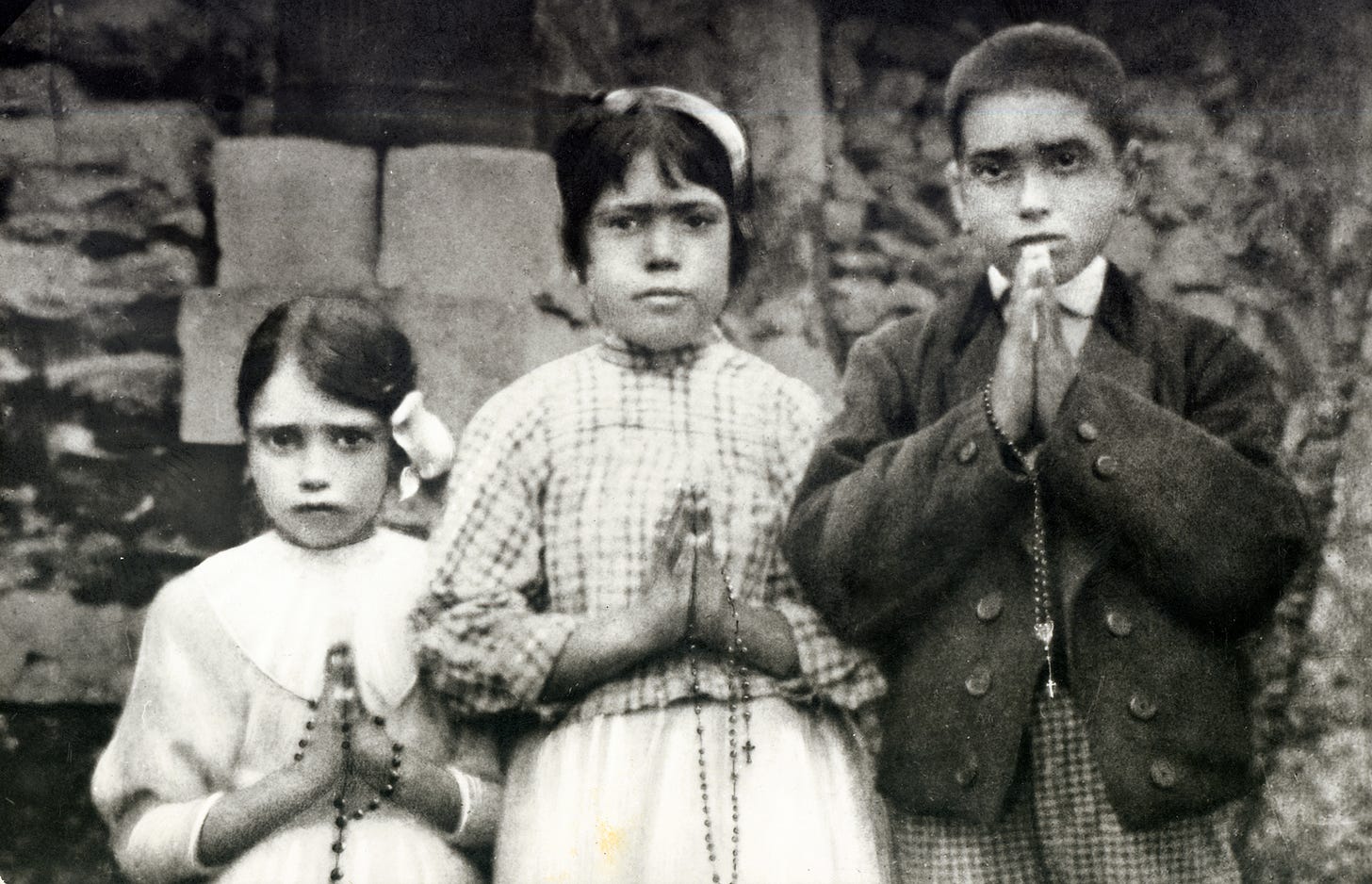
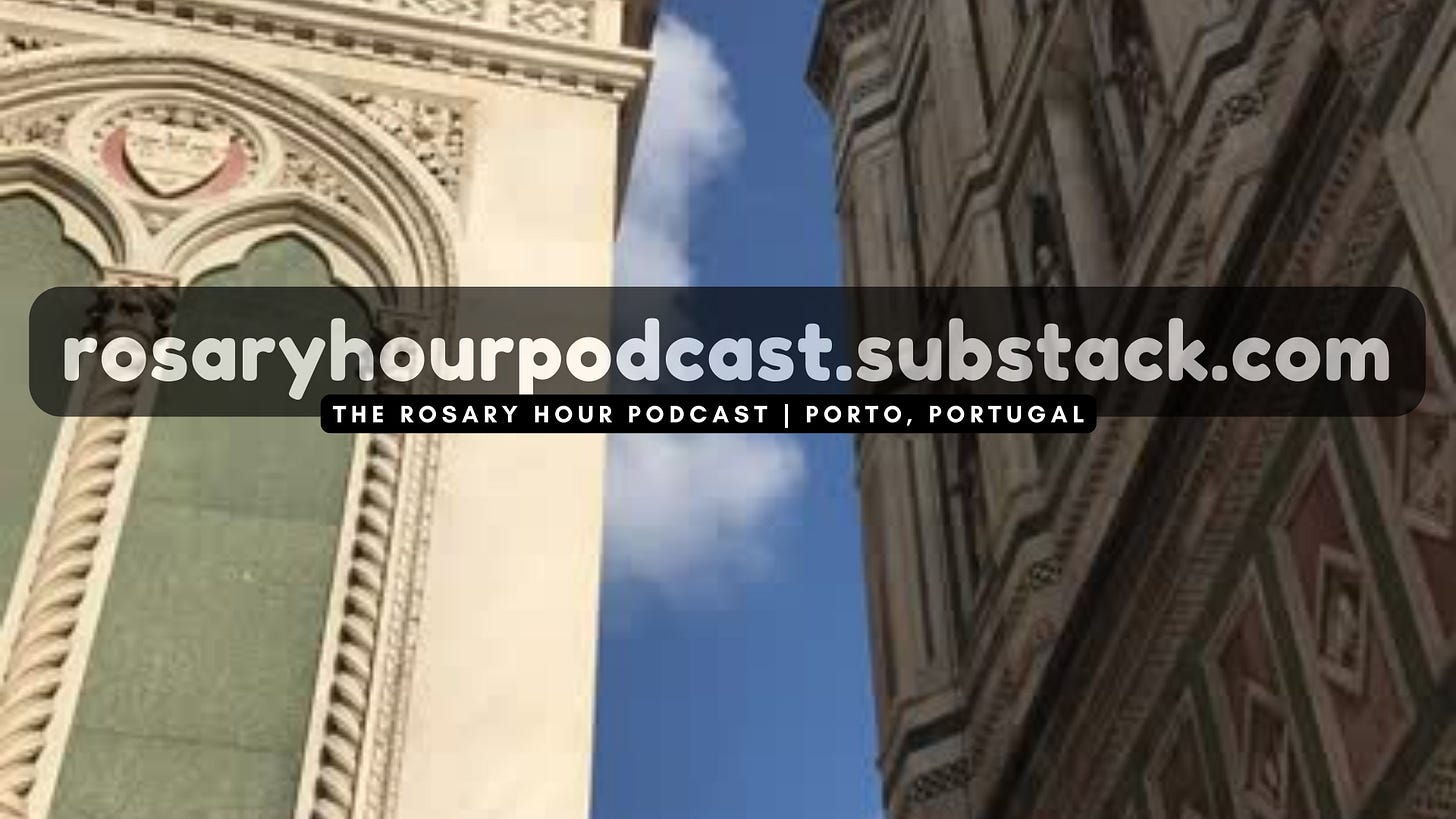

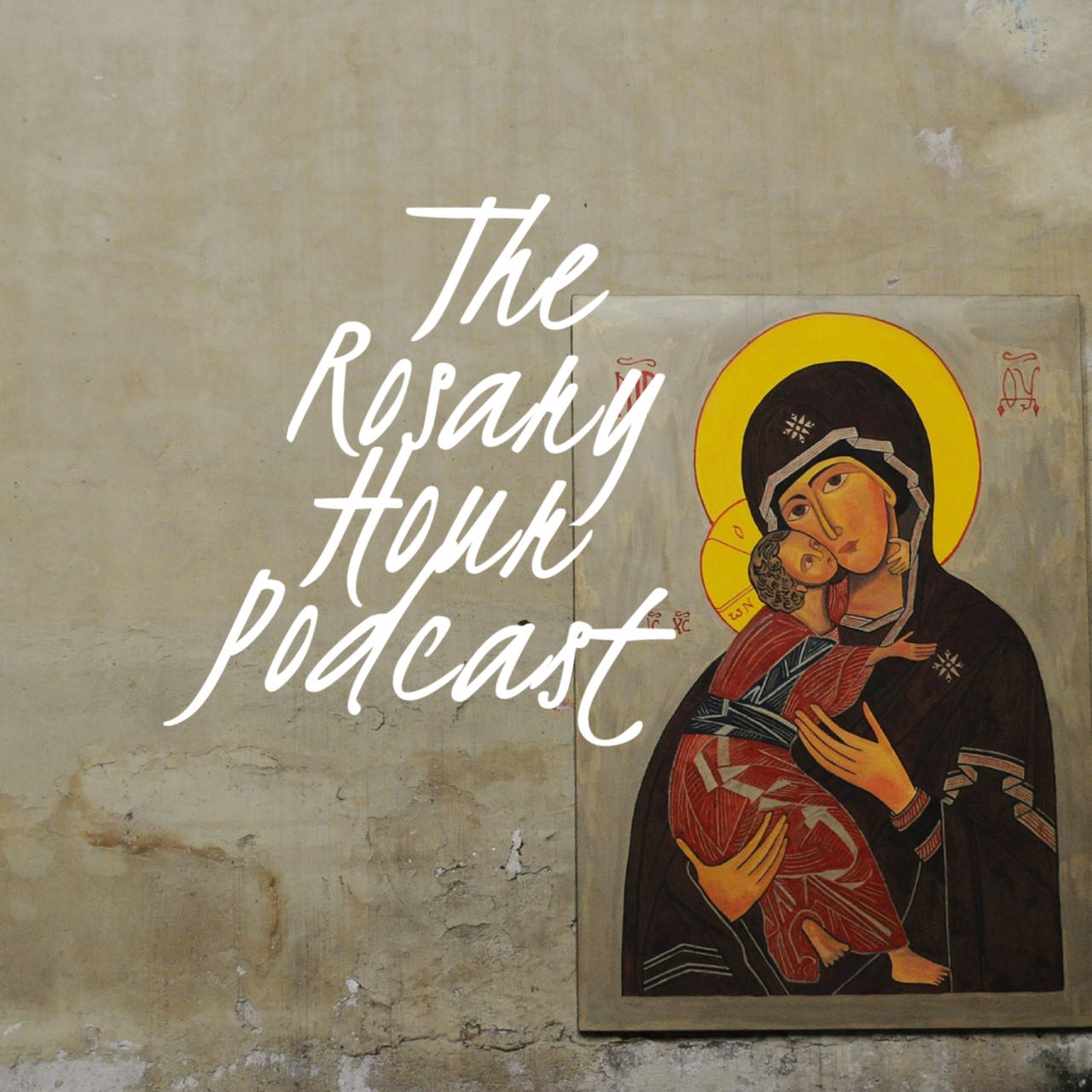



Share this post